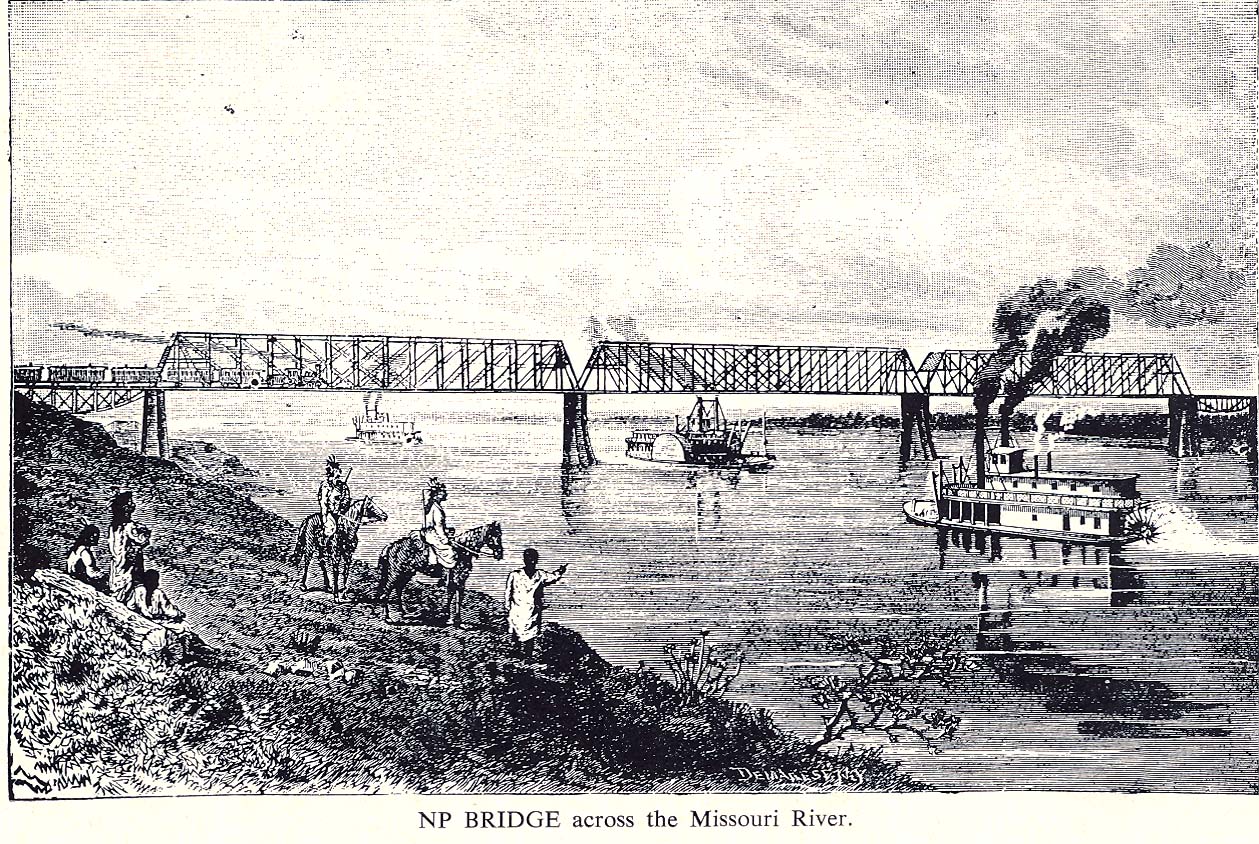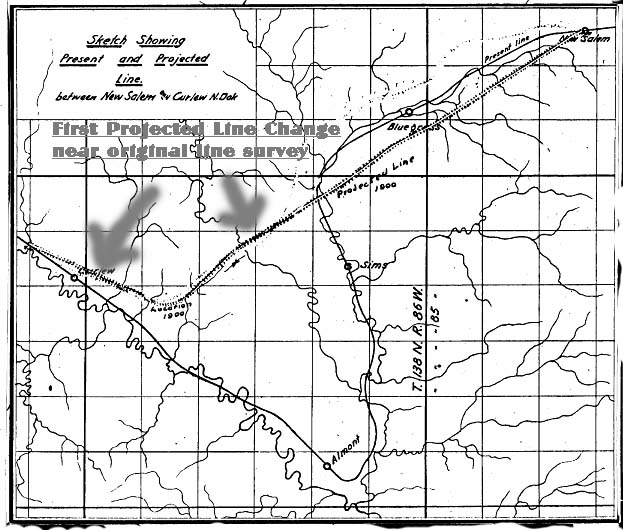Almont North Dakota
1906 Centennial 2006
Railroad
Early History and Eventual Moving of the
Railroad
or
"the birth and death of Almont as a trade center"
The early history of Almont really begins with the beginning of the Northern Pacific Railroad. The NP began on July 2, 1864 when the charter was signed by President Abraham Lincoln to build a railroad from the Great Lakes to the Pacific Ocean. One could even stretch the beginnings back to the Lewis & Clark expedition of 1804-1806, one hundred years before Almont was founded, since the railroad followed much of their path through the Rocky Mountains. Surveying for the railroad was started in 1869. Ground breaking for the railroad began in Minnesota in early 1870 and construction later that same year. It was finally completed end to end in 1883.

From:'The Northern Pacific Main Street Of The Northwest' by Charles R. Wood and published by the Superior Publishing Company.
The records of the Northern Pacific Railroad found at the Minnesota State Historical Society show that early surveys done in the mid 1870’s did not include Almont. The RR was to go from New Salem to the Sims Creek near the Johnson and Bakken farms, then head over the hills to Curlew. The records indicate that when the construction crews got to that point they decided it was too difficult to go over the hills and followed the creeks on a route that became Sims and Almont and then up the Muddy Creek to Curlew and Glenullen. Almont was merely a siding on the RR named by the construction crew. Sometime after a telephone booth was placed at the siding. The first Railroad Station Building came shortly after the founding of the town. The following is taken from the book of Names on the Northern Pacific Railroad compiled by the company when the railroad was completed. "The name Almont is derived from Altamont and is used as the name of this place because of the buttes of the Altamount Morain seen in this vicinity. Alta is a Spanish word meaning-high, and Mont is a French word meaning Hill or mountain. Morain is the earth etc. moved & deposited by a glacier. The station was established in 1883 when a siding was constructed here." It was a beautiful setting in the long wide valley surrounded by the hills so familiar to many of us. Construction in this area was done in 1879-1880. The Railroad was to follow this route for 67 years, until 1947, when it went directly from New Salem to Glen Ullen. Our thanks goes to men like those above who made the choice that resulted in Almont being placed on the map.
The magnificent bridge over the Missouri in Mandan was completed in October 1882 and remains functional to this day. Prior to that goods and people were transferred across the Missouri by boat in the summer and by tracks built on the ice in the winter.

From:'The Northern Pacific Main Street Of The Northwest' by Charles R. Wood and published by the Superior Publishing Company.
 |
The
first effort by the railroad to change the route was
about 1900. There was great competition between the Northern
Pacific and the Great Northern for passengers and freight
from Minneapolis to the Pacific Ocean. Every effort was
made to change the route to save time required to travel
from Chicago to the West Coast. Even small amounts of
time were important in the competition. It also would
have saved a 250 foot decent from New Salem to Almont
and then a climb back up to Glen Ullen. There was also
the factor of the sharp curve (said to be the sharpest
between Minneapolis and the Pacific Ocean) making the
trains slow down considerably. The initial study was
completed in 1902 and concluded that the cost of $464,710.00
would not be worth it. In recent years this is known
as being cost effective. Two other studies were carried
out between 1910 and 1928 with the same results. Finally,
in 1947, when we entered the era of large earth moving
machines it became a reality. |
|---|
The Northern Pacific applied to the Interstate Commerce Commission in 1944 to change the railroad and eliminate Sims and Almont from the route. Their plan was first to work with the Occident Elevator Company to get their cooperation. Correspondence indicated a large payment of some type ensured the cooperation of the Occident Elevator Company. My guess, admittedly only an educated guess from reading the personal communications between the companies, is that the Northern Pacific agreed to pay for the cost of moving the elevators from Almont to North Almont. One of the elevators blew over in a storm while being moved in 1947 and I think its safe to say there was considerable joy in the hearts of members of the community that early morning. I also found direct evidence that the Northern Pacific Railroad tried to hire a 'Spy' from within the Almont community to keep them informed on what possible action the businessmen of Almont might take to try and stop the move of the railroad. I found no evidence they ever found anyone willing to share such information. In fact one letter was lamenting the fact that they were unable to find anyone to keep them informed. The businessmen of Almont ultimately decided not to try and oppose the move but to try and have them keep open a branch line to Almont from New Salem. However it appears that failed when the Occident Elevator opposed that plan.
The final ICC report was issued in June 13th of 1945. The
report included the following information:
-Moving the railroad would save 9.3 miles
and 10-15 minutes per train.
-Sims had 98 people. (I am not sure where
they got that information.)
-Almont had 232 people
-A railroad station was located in Almont.
-Almont had the following businesses:
-2 general stores
-2 grain elevators.
-1 lumber yard.
-1 stock yard
-1 Bulk Oil
Station
-1 Creamery
-2 Gas Stations.
-2 Bars
-1 Combination
Hardware store and Farm Implement Store.
-3 Churches.
-1 School Grades
1-12
(the
last 5 items were not listed in the ICC report.
-The owner of the elevators favored the change
and wanted a new siding on the new route to move its elevators too.
-Predicted results of moving the Railroad
-Creamery would close (it did
within one year)
-Oil and gas Station - no effect
for many years.
-Groceries--One owner predicted
eventually only bread, Ice cream and meats would be sold there. He
sold his store, moved to Mandan and started a grocery store that became
one of the largest and most successful Super Value stores in the upper midwest.
-Lumbar business- would have
increased costs to truck the lumber in.
-The schools would receive much
less because of loss of tax revenue but the ICC said this was
not a factor to be considered.
Their final ruling was to approve moving the railroad and provide no
service to Almont. The final train ran on December 2, 1947.
There is no question that moving the railroad route had a
very negative economic effect on the town businesses but because of
its tremendous support and loyalty of the local residents Almont businesses
continued to thrive for several years.